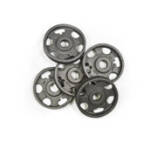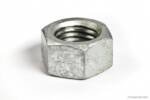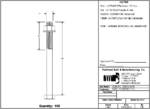Newest FAQs
There are many grades of nuts available in the marketplace, from your “run of the mill” nuts like you’d find at a hardware store, to specialized high strength structural nuts. These nuts are made from different materials and get their strength in different ways. Low strength nuts are made from a variety of materials and... Read more
There are several ASTM specs which cover castings, including A47, A48, A536, and A668. ASTM A47 A47 covers malleable castings intended for general use up to temperatures around 750⁰ Fahrenheit. A47 castings come in one grade, available in metric and imperial. Common forgings specified to A47: Shear Plates, Beveled Washers ASTM A48 A48 covers gray... Read more

The “X” designates the connection type (bearing-type connection with threads excluded from the shear plane) and has nothing to do with the bolt itself. Therefore, an A325 structural bolt used in this type of connection will have no different markings than an A325 bolt used in a different type of connection (N or SC). All A325... Read more
The term “high strength” is a somewhat ambiguous fastener term. Most people in the industry would interpret the phrase “high strength” to refer to any bolt that has been quenched and tempered (heat treated) to develop its strength. Additionally, the ASTM specification F1554 Grade 55 is commonly referred to as being manufactured from a “high... Read more
AASHTO is the American Association of State Highway and Transportation Officials. This organization sets standards for highway design and construction. As it relates to bolts, often times, bolts and other materials will be shown on plans for state transportation projects as having an AASHTO designation. These AASHTO numbers typically will correlate directly to a particular... Read more
I have noticed in specifications from multiple organizations that ASTM A193 Grade B7 bolts are selected along with ASTM A194 Grade 2H nuts. I know that from ASME B16.5 Flanges and Flanged Fittings, the recommended high strength bolt is ASTM A193 Grade B7. However I cannot find in ASTM A193, A194, ASME B16.5, B18.2.1, B18.2.2, B31.1... Read more
A common misconception is that stainless steel is non-magnetic. There are five classes of stainless steel, and only one is non-magnetic. However, it just happens to be that the most widely used type (austenitic) is the one that is not magnetic. Class Magnetic? Common Types Ferritic Yes 430,442 Austenitic No 304,316 Martensitic Yes 410,416 Duplex... Read more
Basically, there are 3 different configurations of threads: Full-body cut thread Reduced-body rolled threads Full-body rolled threads Full Body Cut Thread Full body cut threads use full size round bar and the threads are cut into the steel. This is a commonly used method, especially on larger diameter products, long length products, and small quantity... Read more
The short answer to this question is no. However, there are many variables with regard to the protective coating that prevents the internal threads of a galvanized nut from corroding. In this FAQ, we will explore some of the variables brought about by this question. One of the first issues to address is the question... Read more

Yes we do. Our quoting program is designed to automatically send drawings with all items we quote. We can also create any other drawings you may need. Drawings minimize the possibility of both verbal miscommunication and written misinterpretation. Our drawings will define exactly what we are planning to supply and give you the ability to... Read more

